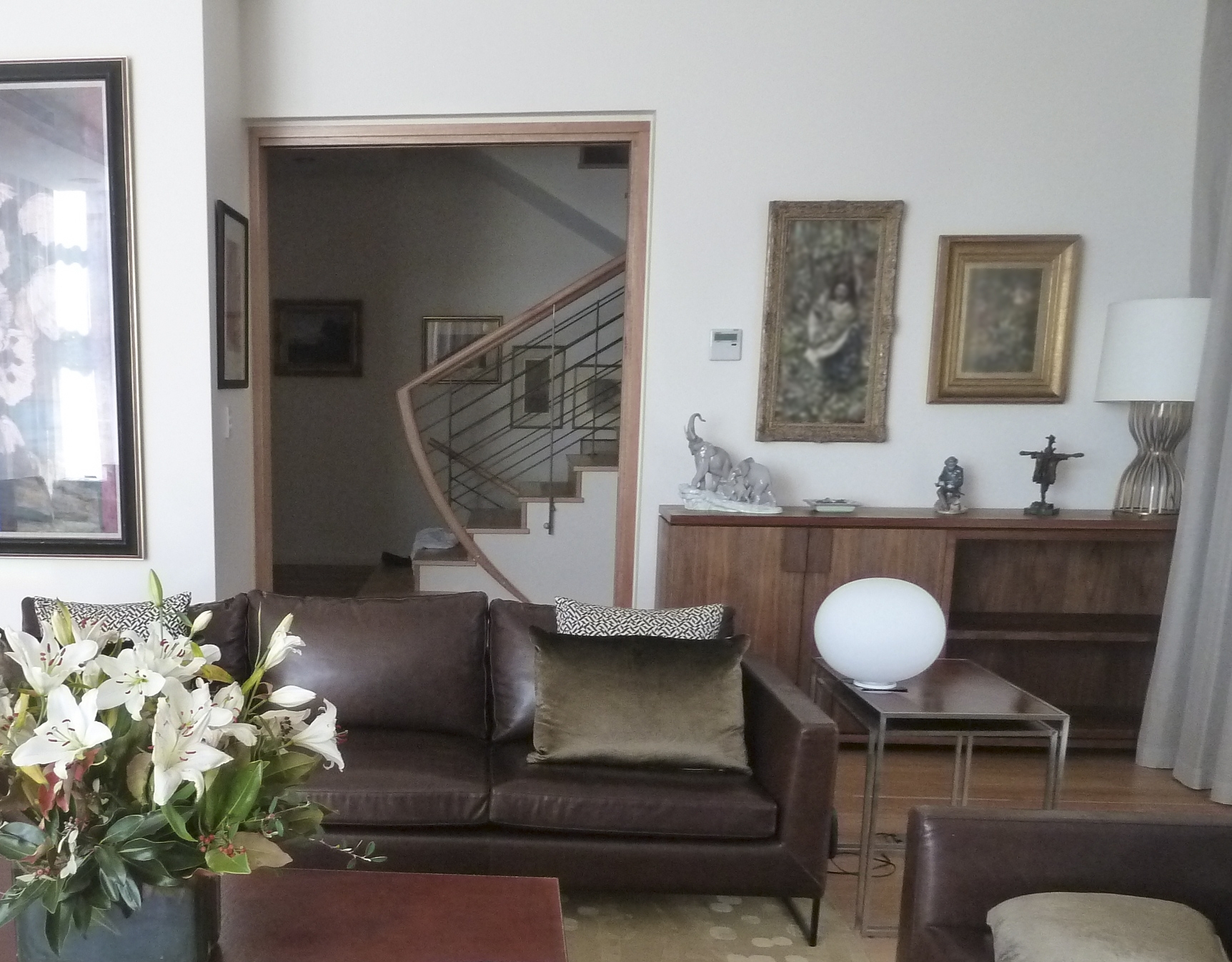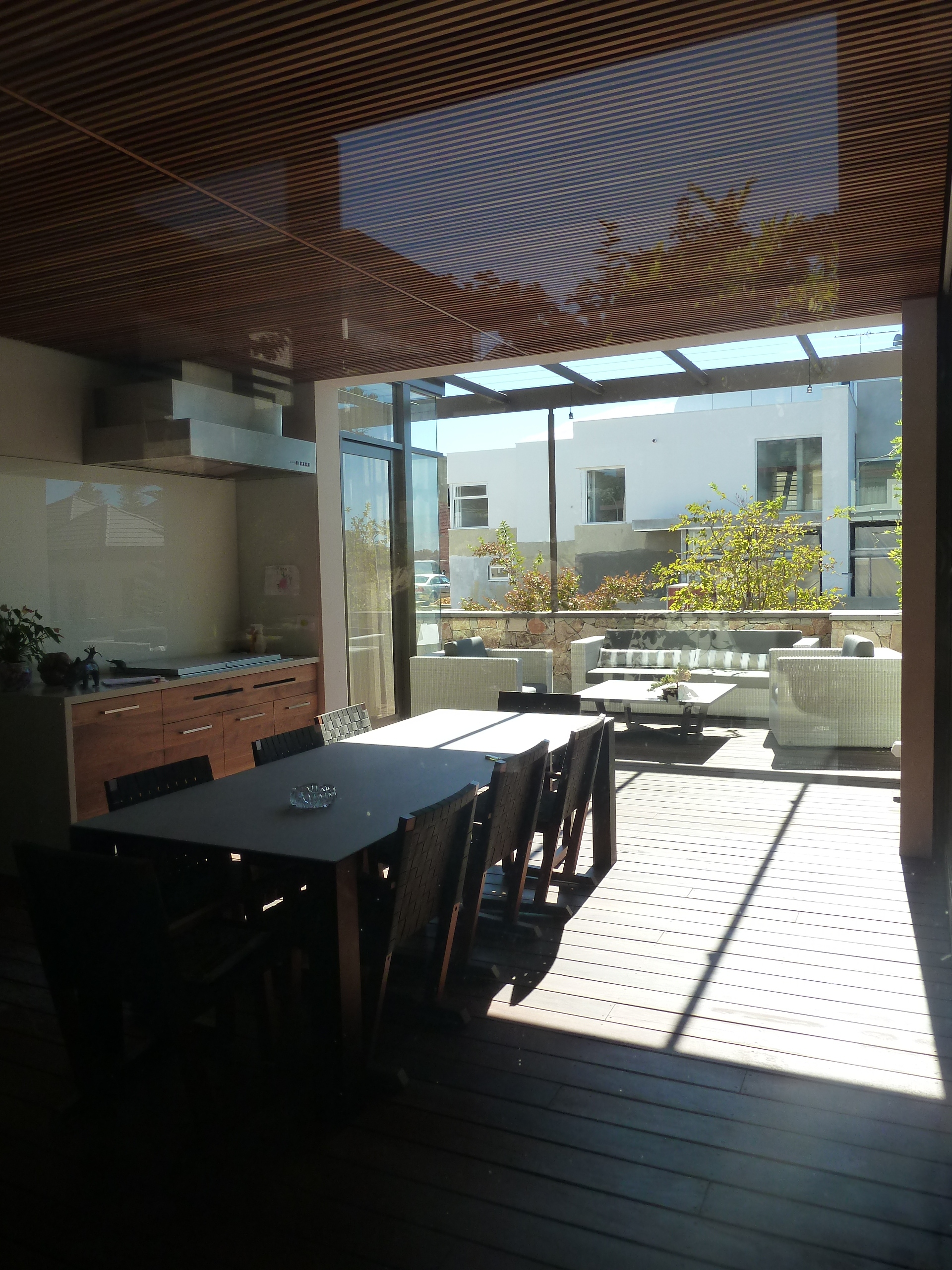Peppermint Grove
Aging in place, masculine, feminine, artwork, cigars, river view, streetscape, Beereegup, Minderup.
His & Hers House provides the owners, a retired couple, with living spaces specific to each of their distinctive personalities while allowing them both to comfortably age in place. The house enjoys views to the Swan River with the living room and outdoor entertaining areas elevated above street level where both security and outlook are catered for.
The design service provided by Neil Cownie was holistic in the provision of the architectural design, interior design, furniture selection, curtains, the design of items of furniture and lighting, along with coordination of the landscaping.
CLIENT BRIEF
Neil's clients Ross & Ursula a retired yet very active and engaged couple moved to Australia from the UK to live alongside their daughter, her husband and their grandchildren. Unique to this experience was the opportunity to design two houses alongside one another that could serve the three generations of family.
Ross & Ursula wanted convenient access to their adjacent family without having to leave to do so via the street and front doors. The house needed to provide for their needs to allow them to age in place, with a lift and a suite for international guests and eventually perhaps live in nursing assistance.
The brief also required distinctive living areas within the house for each of them. For Ross who formerly held the title of ‘World Bridge Champion’ a place to allow him to enjoy smoking his much-loved cigars in a darker environment with the feel of a ‘masculine den’. While for Ursula we needed to achieve a light filled colourful and fun space for family and entertaining. As they owned some large prominent artwork, it was important to design from the outset with the artwork in mind to ensure we had sufficient wall space.
HISTORY OF PLACE AND PEOPLE
The Aboriginal people associated with the Freshwater Bay area were part of the Whudjuck Nyungar group (Collard1997). The district containing Peppermint Grove & Claremont was known as Mooro and belonged to Yellowgonga’s group. This family unit of about 32 people is thought to have been the main occupants of the area which includes Peppermint Grove.
Nyungar people are thought to have lived in small, dispersed family groups during winter moving through the hills and Upper Swan area. In summer and autumn larger groups assembled at sites along the lower reaches of the Swan estuary for ceremonial and social purposes. In Claremont and Peppermint Grove freshwater springs in the northern and
western sides of the Bay would have provided water and people could catch crabs, waterfowl and fish and harvest bush food, animals, snakes and lizards from the surrounding bush. Lake Claremont, then a freshwater swamp also had shellfish, tortoises, frogs and reed rhizomes for damper and other bush food like Zamia nuts as well as paperbark resources to use to build shelters. (Claremont Museum). Noongar people called the bay Minderup, which means ‘place for alleviating sickness’.
Peppermint Grove was settled by Europeans in 1835 when an innkeeper named John Butler was given a grant of land along the bank of the Swan River, the area now known as Peppermint grove. The area at that time was cleared and used for farming and pasture. The area known at the time as ‘Butler’s Hump’ was purchased by Edward Keane in 1891 who built a family home there that was known as Cappoquin, named after their hometown in Ireland. Keane died in 1904 and the land fell into public hands and by 1920 was used for disabled returned soldiers and was known as ANZAC Hostel which catered for 19 patients. By 1928 the need to caterer for the returned soldiers had diminished and the area became a popular camping ground.
Peppermint Grove in the 1880’s enjoyed prosperity and better access due to the arrival of convicts who constructed roads and a railway that pierced through the area. The area became a highly desirable location due to this accessibility between Perth and Fremantle, the proximity to Cottesloe beach and the Peppermint Grove River foreshore. Peppermint Grove first became a residential suburb around 1892 coinciding with the WA Gold Rush when prominent families built their homes in what was considered a prestige area.
The beauty of the bay and its suitability for sailing prompted the establishment in 1896 of a yacht club was which formed at the foot of Irvine Street in Fresh Water Bay and a jetty was built to house the boats. In 1897 the Fresh Water Bay Yacht Club held its first official race. In 1934 the club received its Royal Charter and became known as the Royal Fresh Water Bay Yacht Club. In 1936 the club moved to Cappoquin on Keane’s Point, the family home of Edward Keane.
LANDSCAPE AND GEOLOGY
The site of River House had a 4.5-metre change in level from the high point at the west and low point on the river side. Our design turned the large change in level to our advantage by terracing the outdoor landscaped areas in a series of levels which opened up the view to the river. The swimming pool and deck being at one of the lower levels provided a destination in the garden. Using he change in level to conceal the children’s cubby house, a ‘cave’ proved to be a very popular design outcome. We designed a granite rock cave at the lower end of the garden that cut back into the higher-level ground. The cave is set within a portion of the garden that has a Jurassic feel about it. Landscaping plays an important role in the outdoor terrace where Wisteria vines provide dappled summer shade below the glass roof.
The geology of the Peppermint Grove area warrants its registration as a Geoheritage site.The Tamala Limestone at Peppermint Grove is part of one of the largest rock units in the world as it stretches for more than 1000km between Shark Bay and Esperance, is up to 10km wide onshore and up to 40km offshore. While often referred to as an aeolian (wind formed) dune system, the Peppermint Grove site demonstrates much more geological variability as there is evidence of shallow marine beds and beach deposits, which can be recognized by the fossil shells or by the nature of the bedding in the limestone. The clifftop high points to the northwest of Fresh Water Bay were once ancient dunes formed by winds blowing from the south-southwest. From the top of the cliff, you can view the circular nature of Freshwater Bay, suggesting it may have once been one of the lakes, like Lake Claremont, situated in a swale that parallels the coast.
The age of the Tamala Limestone in the Peppermint Grove area is approximately 300,000 to 240,000 years before present making it considerably older than the Tamala Limestone sections on Rottnest Island, all younger than 140,000 years.
The name ‘Freshwater Bay’ relates to the freshwater that was once readily available from the edge of the Bay. Historically the ‘Swan River Chart, prepared by HMS Beagle in 1841 refers to ‘freshwater oozing through the sand’ in the area in the northwestern corner of Freshwater Bay. Photographs taken early this century show a number of wind pumps along the shoreline on the western side of the bay, presumably to exploit the freshwater resource. The springs are now less apparent, probably due to the intensive exploitation of groundwater over the past decades.
ARCHITECTURE AND DESIGN
This house was designed in conjunction with the adjacent house, River View House, with the two houses interacting in both private outdoor areas and in the public realm where they work together to provide some consistency in an otherwise ‘haphazard’ streetscape.
The house is situated on a sloping corner site and has guest access to the front door from one street at the high point, and vehicle access to a basement garage from the other street where the ground levels fall away towards the river, allowing less ramping down to the basement. Living areas are all at ground floor which becomes effectively half a floor level above ground at the point of the north facing outdoor entertaining area. This partly elevated outdoor entertaining area has a one-meter-high stone balustrade which from street level is a 1.8m high stone screen wall. This is important to the intended design outcome of avoiding the need for the usual security fences along street front boundaries. The resulting open nature of the house to the streets due to the avoidance of fences allows the owners, Ross & Ursula to have visual engagement with the happenings within the street without feeling isolated.
Through considerate planning views to the river are enjoyed from the two internal living areas at ground floor, the external entertaining area and both the master bedroom and second and third bedrooms at first floor.
Internally timber finishes feature in handrails, cabinetwork, detailing and to floors. Ross & Ursula’s artwork collection populates every wall space throughout the house. Externally alluvial granite stonework walls provide a base to the house which has otherwise a ‘clean’ statement of white walls topped with a slate roof.
SUSTAINABILITY
The planning of the house has been arranged to achieve maximum benefit from an orientation to the north for winter solar penetration to the house. With a view to the east the river, the windows with this orientation are provided with remote controlled external aluminium blinds. The floor plan ensures that the external areas are protected from the cold prevailing winds from the south and west.
The roof of the house is generally clad in slate, with a large portion of the north facing roof over the master bedroom clad in ‘Nu-Lok solar panels’ that are in the same small scale and are laid lapped in the same way as the slate roofing. The hot water to the house is provided by a heat pump.
PHOTOGRAPHERS
Robert Frith
























